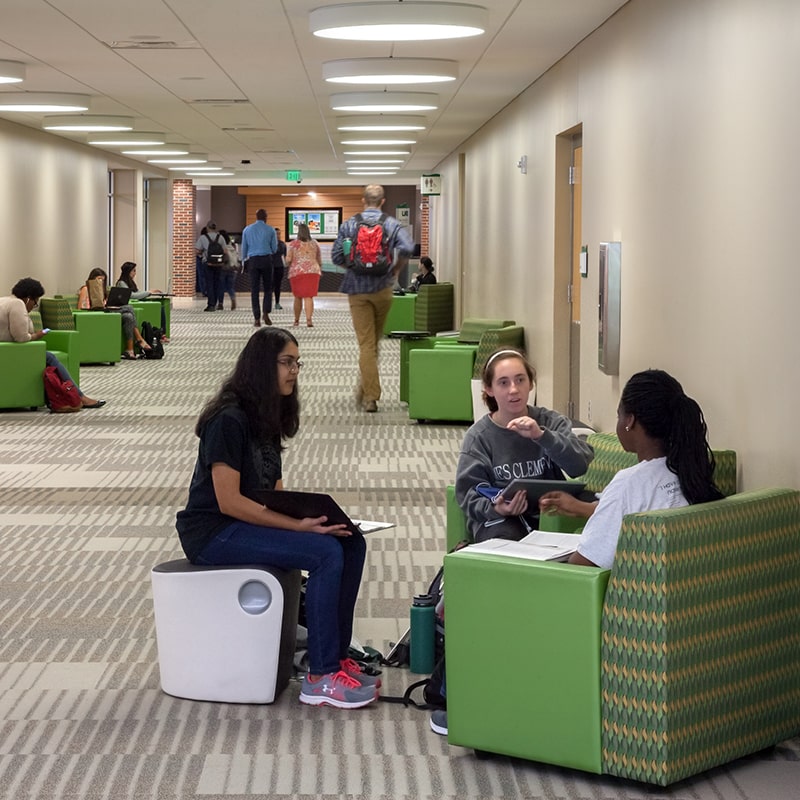How Architecture Supports Your Diversity, Equity & Inclusion Initiatives

Wednesday, August 18, 2021
As higher education architects and designers, examining national trends in enrollment is an essential part of our work. Not only does this research help us better understand our clients, it also ensures our design approach best supports student needs and enhances the competitive position of an institution. In recent our article, Designing Spaces that Promote Learning and Improve Retention, we shared that in Fall 2020, colleges and universities nationwide observed a substantial, pandemic-induced 13 percent drop in overall first-time undergraduate enrollment. This trend was sustained through the first half of 2021 as updated figures from the National Student Clearing House Research Center (NSCRC) demonstrate that overall college enrollment fell to 16.9 million students this spring, down more than 600,000 students from a year ago. This one-year decline of 3.5% from 2020 to 2021 is the largest spring semester enrollment decrease since 2011. The NSCRC findings are an indicator of the enrollment climate higher education as a whole will experience going forward. In a June 2021 press release, Executive Director of the National Student Clearinghouse Research Center Doug Shapiro comments, “The final estimates for spring enrollment confirm the pandemic’s severe impact on students and colleges this year. How long that impact lasts will depend on how many of the missing students, particularly at community colleges, will be able to make their way back to school for the coming fall.”
While the decline in enrollment may be less than may higher education leaders anticipated, there are still many questions our design experts are posing in light of these statistics. Will institutions bounce back from lagging enrollments as we learn to better live with COVID-19 and its effects? How quickly will recovery happen? Can colleges help students get their higher education plans and goals back on track, particularly those of low-income and minority status significantly impacted by the pandemic? How can higher education engage students who took gap years due to the uncertainty of COVID-19 in the 2020-2021 school year? Our design experts are utilizing our Architecture of Enrollment Management® service to explore these multi-faceted questions for colleges and universities across the country. Through this approach of considering the relationship between the strength of physical facilities and student enrollment, our design experts can help determine how to best attract and retain students within the context of an institution’s built environment. One of our biggest design considerations in recent years is how facilities can support the Diversity, Equity, and Inclusion (DEI) initiatives of colleges and universities. Our design experts expect this focus will be key in helping colleges and universities recover from the impact COVID-19 had on national college enrollment. Here are a few practical strategies our design professionals are implementing to help campuses live out their DEI initiatives through architectural design.
- Revamp the design of welcome centers and other admissions-related spaces. As colleges and universities face an increasingly competitive market for student enrollment in the coming years, spaces that serve prospective students and their families will be paramount. Our designers suggest improving these spaces to be more welcoming and inviting. This could involve designing spaces that encourage dialogue and chance meetings of prospective students. Admissions-related spaces may also be located in close proximity to DEI-oriented offices, signaling to prospective students that their unique needs can be met at a given institution.
- Ensure student service centers and relevant administrative offices are centrally located. Conveniently locating essential student service functions promotes inclusivity and access for diverse students. Planning and programming a student center or union around key functions such as career services, disability services, transfer student centers, and multicultural offices is important in creating visibility of such programs offered by a campus and increases the likelihood of these services being used.
- Optimize common spaces to serve all students. Campuses have significant opportunity to cater the educational experience to the day-to-day lives of their students. For example, providing physical gathering spaces and amenities like ample dining options can help make students who live on campus and those who commute more comfortable spending time on campus during the school day. Offering adequate spaces for group collaboration and quiet study and adapting existing spaces accordingly can be a game-changer in helping underserved students feel more welcomed and supported in the collegiate environment.
Hastings+Chivetta’s design experts look forward to helping clients fully understand the effects of COVID-19 on their enrollment and brainstorming effective design solutions geared toward attracting and retaining students of varied backgrounds.
To discuss how we can help your campus develop an innovative response to enrollment management challenges or uncertainty, contact Erik Kocher at [email protected] or (314) 529-4004.